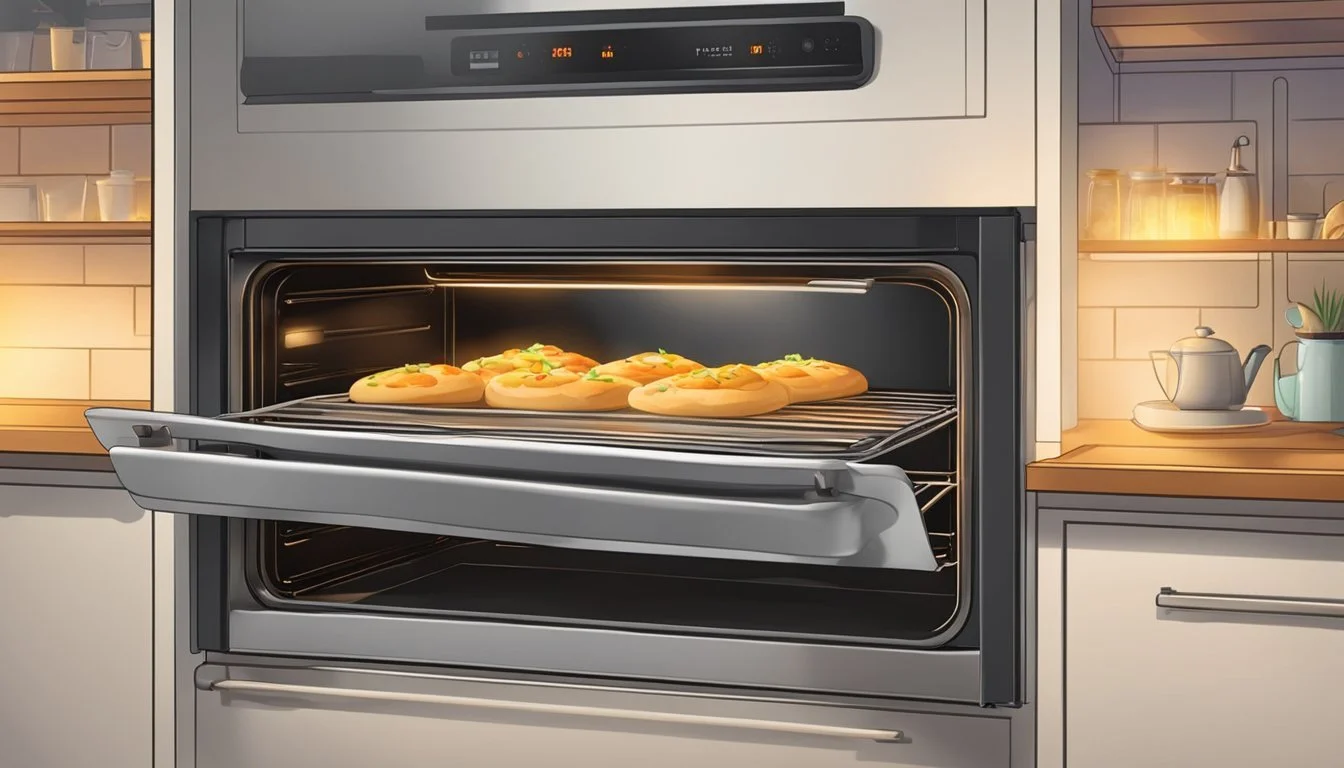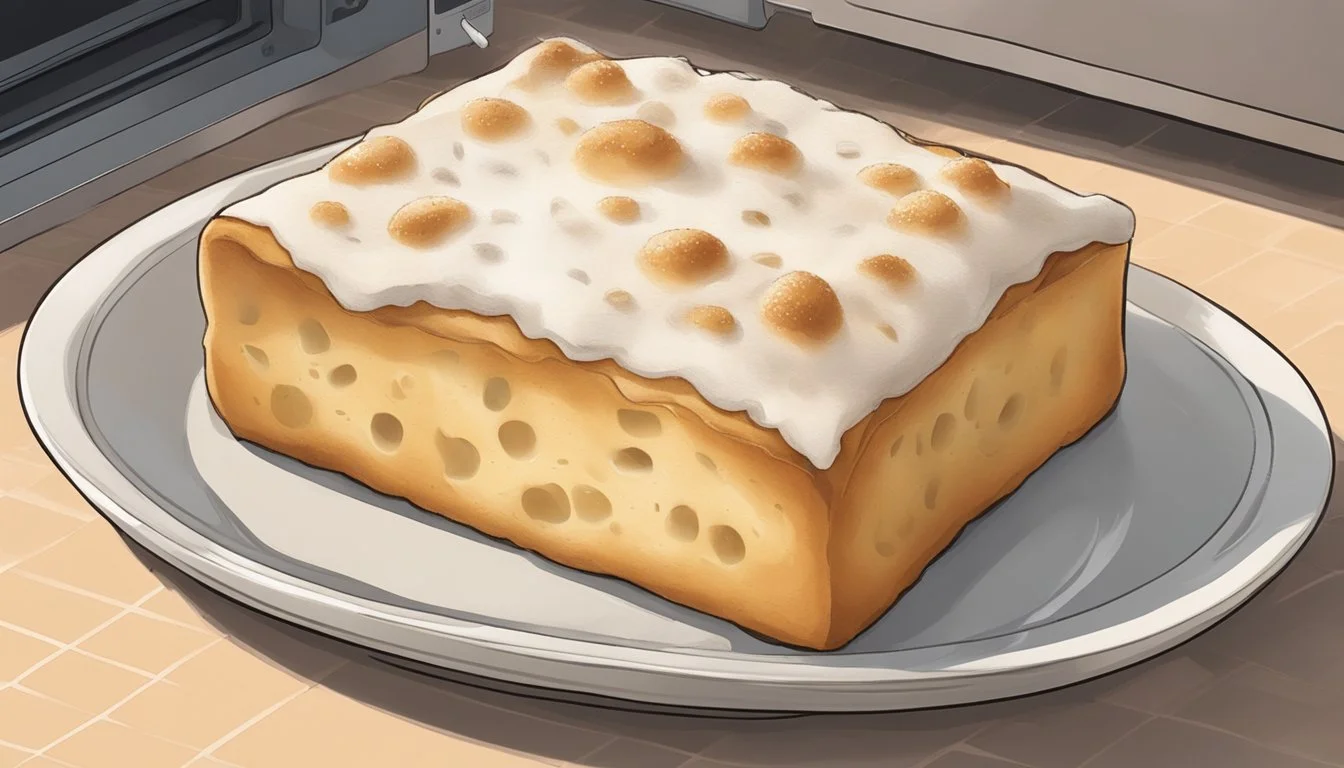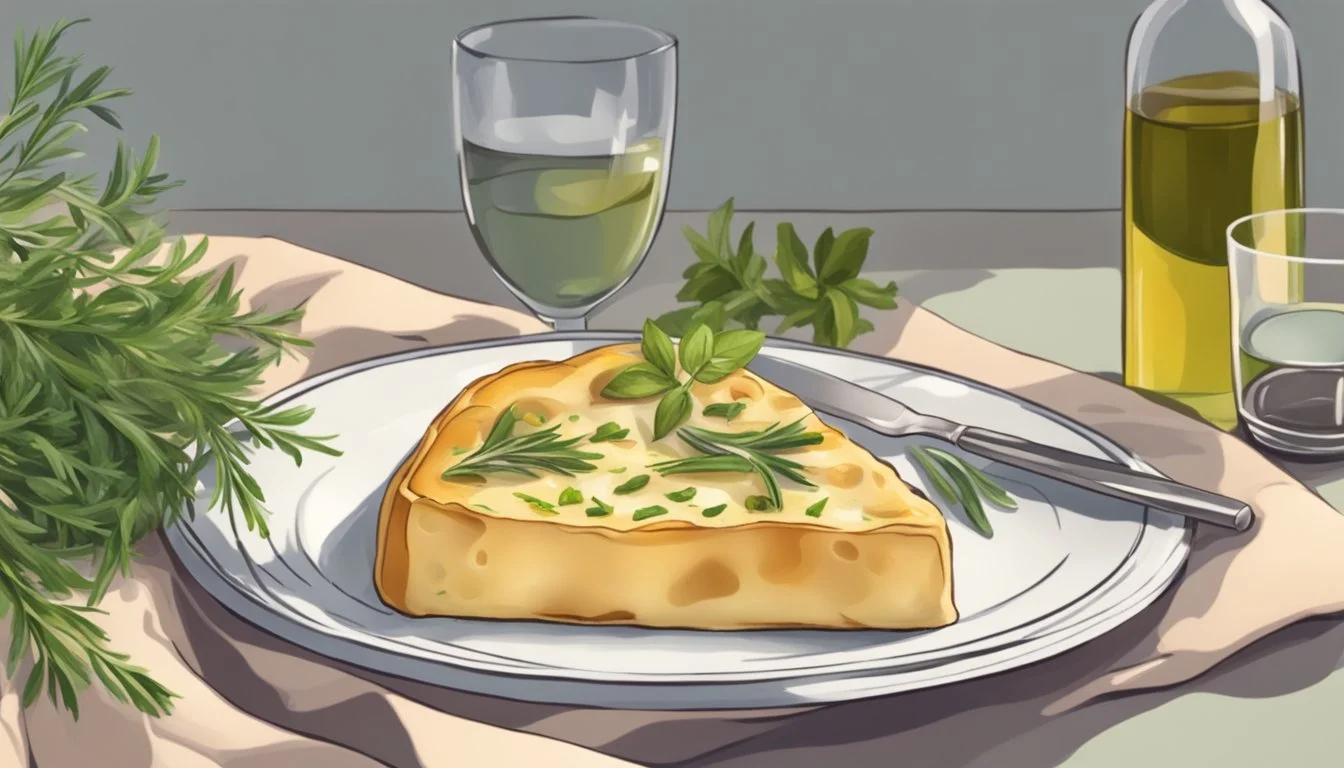Best Way to Reheat a Focaccia
Ensuring Softness and Fluffiness Every Time
Reheating focaccia to achieve a balance between a soft and fluffy interior with a crisp crust can be a delicate task. Focaccia, an Italian flatbread (What wine goes well with bread?) known for its olive oil-infused flavor and airy texture, loses its appealing qualities when it goes stale. Maintaining its freshly baked bread essence requires a method that respects the bread's structure while restoring its warmth and texture. The key is to emulate the original baking environment to recapture the fresh-out-of-the-oven experience.
Various techniques exist for warming focaccia, but not all provide the same results. Care should be taken to avoid over-drying or toughening the bread. The methods range from using an oven, which is capable of evenly distributing heat and recreating the bread's initial crispness, to more rapid approaches, like employing a skillet or toaster oven for a quicker fix. Each technique has its merits and can be suitable depending on the circumstances and available resources.
Understanding Focaccia
In exploring the best ways to reheat focaccia, it's essential to understand its unique properties and the variety that exists within this category of Italian flatbread.
Characteristics of Focaccia
Focaccia is a traditional Italian flatbread known for its chewy texture and rich flavor derived from olive oil. Typically about an inch or two thick, its surface is punctuated by dimples created by pressing fingers into the dough prior to baking. These dimples not only create the classic look but also help to distribute the oil and allow for the even absorption of toppings and seasonings, such as herbs and coarse salt.
The crust of focaccia should be crisp and slightly golden, offering a delightful contrast to the soft, fluffy interior. Rosemary is one of the most common herbs used in focaccia, imparting a distinctive aroma and flavor that complements the olive oil. Other herbs, like thyme or oregano, can also be used, either alone or in combination with rosemary to enhance the bread’s flavor profile.
Types of Focaccia
There are several variations of focaccia across the different regions of Italy, showcasing a range of flavors and toppings:
Focaccia Genovese: Originating from Genoa, this version is simple yet flavorful, primarily seasoned with olive oil and salt.
Focaccia Barese: From Bari, this variation includes tomatoes, olives, (What wine goes well with olives?) and sometimes oregano, offering a more savory taste.
Focaccia di Recco: A specialty of Recco, near Genoa, this type is filled with creamy Stracchino cheese.
These regional differences illustrate not only the versatility of focaccia but also highlight why understanding the specific type of focaccia one is working with is critical for proper reheating techniques to maintain its characteristic texture and flavor.
Preparation for Reheating
Proper preparation is crucial for reheating focaccia to restore its soft and fluffy texture. The success of rejuvenating leftover focaccia hinges on assessing its initial condition and correctly preheating the oven.
Assessing the Focaccia's Condition
Before one proceeds to reheat focaccia, they must evaluate its current state. If the focaccia has been properly stored in a cool, dry place or in the refrigerator, it is more likely to retain moisture and texture. Stale focaccia will need additional care, such as a light sprinkle of water, to help it regain a desirable quality. One should also check:
Moisture level: Is the focaccia overly dry?
Surface condition: Is it oily, or has it dried out?
Firmness: Is the focaccia hard and stale, or still somewhat soft?
Preheat the Oven
To ensure even reheating, one should preheat the oven. This step provides a consistent and controlled environment for the focaccia. The recommended temperature settings are typically around 350°F (175°C) for a conventional oven. Here's how to do it:
Turn on the oven: Set the temperature to 350°F.
Position the rack: Place it in the center for even heat distribution.
Wait for the preheat: Ovens typically take about 10-15 minutes to reach the correct temperature.
Consistently reheated focaccia begins with proper preparation. One must assess its condition and preheat the oven to lay the foundation for a soft and delightful bread experience.
Reheating Methods
Reheating focaccia effectively restores its warmth and texture, making the choice of method pivotal to retain its softness and fluffiness.
Oven Method
One reheats focaccia in the oven by preheating it to 350°F and wrapping the bread in aluminum foil before placing it on the oven rack. The approximate warming time is 10-15 minutes. For a crisper crust, one should remove the foil and let the focaccia heat directly on the rack for the final 2-3 minutes.
Microwave Method
Although not ideal for crispness, the microwave offers a quick alternative. One can place a slice of focaccia on a microwave-safe plate, cover it with a damp paper towel, and heat on high for about 20-30 seconds. This method may not re-crisp the crust but will keep the bread soft.
Stove Top Method
Reheating focaccia on a stove involves heating a skillet over medium heat and placing the focaccia in the pan without oil. The bread is covered with a lid and heated for 2-3 minutes on one side, then flipped and heated for an additional 1-2 minutes to warm thoroughly.
Toaster Oven Method
A toaster oven is used by first preheating to 350°F. The focaccia is placed directly on the rack or on a baking sheet, loosely covered with aluminum foil, and heated for about 5-10 minutes, checking periodically to avoid overcooking.
Air Fryer Method
An air fryer heats the focaccia efficiently by setting it to 350°F. The bread is placed in the air fryer basket without any need for foil and heated for 3-4 minutes. This method tends to preserve the crust's crispiness while the inside remains soft.
Step-By-Step Reheating Guides
Reheating focaccia properly is essential to enjoy its soft, fluffy texture and rich flavor as if it were fresh. Below are precise methods tailored to different kitchen appliances.
Reheating in the Oven
Preheat the oven to 350°F (175°C).
Sprinkle focaccia lightly with water to maintain moisture.
Place the bread on a baking sheet and heat for 10-15 minutes.
Check periodically to ensure it doesn't overcook for a perfect result.
Reheating in the Microwave
Dampen a paper towel and cover the focaccia with it.
Heat on medium power for 15-20 seconds intervals to avoid over-drying.
Check the warmth and softness between intervals.
Reheating on the Stove Top
Heat a non-stick pan over medium heat.
Place the focaccia in the pan and cover it to trap steam.
Warm for about 1-2 minutes on each side until sufficiently heated.
Reheating in the Toaster Oven
Adjust the toaster oven to 350°F (175°C).
Insert the focaccia and reheat for 3-5 minutes, monitoring it closely.
Reheating in the Air Fryer
Preheat the air fryer to 320°F (160°C).
Place the focaccia in the basket.
Reheat for 3-4 minutes; this method works well for smaller portions.
Each technique ensures the focaccia is warmed evenly while preserving its moist interior and crisp exterior.
Addressing Common Reheating Challenges
When reheating focaccia, maintaining the right balance of moisture and texture is crucial to recreating the bread's original appeal. These strategies will help overcome common hurdles.
Avoiding Dryness
To prevent focaccia from becoming dry, one can lightly sprinkle water on the bread's surface before heating. Wrapping it in aluminum foil also plays a role in locking in the moisture during the reheating process.
Step-by-Step to Retain Moisture:
Preheat oven to 350°F (175°C).
Lightly sprinkle the focaccia with water.
Wrap the focaccia in aluminum foil.
Place in the oven for 10-15 minutes.
Retaining Fluffy Texture
The focaccia's airy and fluffy texture is its hallmark. An oven set to a moderate temperature (350°F - 375°F) allows focaccia to warm up gradually, which helps maintain its spongy quality.
Temperature and Time Guide:
Preheat: 350°F - 375°F
Duration: 10-15 minutes
Preserving the Crust
The crust requires special attention to stay crisp while avoiding hardness or chewiness. For the final 2 to 3 minutes of reheating, remove the foil, allowing the crust to regain its crispiness without overcooking.
Crust Preservation Tips:
Last 2-3 minutes of reheating: Uncover the focaccia.
Optional: Before reheating, brush the surface with olive oil for added flavor.
Enhancing Reheated Focaccia
To elevate the flavors and texture of reheated focaccia, the application of olive oil and the addition of fresh herbs and toppings can be transformative.
Using Olive Oil
A light brush of olive oil over the surface of the focaccia not only helps to maintain moisture, but it also adds a subtle richness that enhances the bread’s taste. For ideal results:
Before reheating: Brush a thin layer of extra virgin olive oil on the focaccia.
After reheating: Drizzle a small amount of olive oil to reintroduce a vibrant depth of flavor.
Adding Fresh Herbs and Toppings
Incorporating fresh herbs and toppings onto the focaccia after reheating deepens its flavor profile and provides a refreshing twist. Here are some considerations:
Fresh Herbs: Sprinkling finely chopped rosemary, basil, or thyme introduces an aromatic element to the focaccia.
Toppings: Post-reheating, scatter a mix of toppings like cherry tomatoes, olives, or a grating of Parmesan cheese over the focaccia for added texture and savoriness.
Seasonings and Vinegars: A pinch of sea salt, cracked pepper, or a few drops of balsamic vinegar can be applied sparingly to accentuate the focaccia's intrinsic flavors without overpowering them.
Serving and Pairing
Once the focaccia is reheated to perfection, with its soft and fluffy interior, it's essential to know how to serve it and what dishes it pairs best with. These choices will enhance the bread's flavor and ensure a delightful dining experience.
Serving as an Accompaniment
Focaccia serves as an excellent accompaniment to a variety of meals. As a side, it can be cut into manageable slices or served whole on a central platter for guests to help themselves.
Soups: A warm slice of focaccia is an ideal companion to both creamy and broth-based soups. Its absorbent nature complements the liquid and enriches the overall flavor.
Salads: Pairing focaccia with salads adds a textural contrast. A crusty piece alongside a fresh salad balances the crispness of the vegetables with the bread's softness.
Pairing with Dishes
When considering focaccia as a part of the main dish, its versatility shines through.
Pasta: Serve focaccia with pasta dishes as a carrier for sauces. It can easily be used to mop up excess sauce, ensuring no flavor is left behind.
Sandwiches: Focaccia's dense structure makes it excellent for sandwiches. One can fill it with an array of ingredients ranging from meats, cheeses, to grilled vegetables.
Storing Focaccia After Reheating
After enjoying the freshly reheated focaccia, it is crucial to store any leftovers properly to maintain its quality. The key is to prevent exposure to air and moisture, which can compromise the texture and flavor of the focaccia.
Using Airtight Containers
For short-term storage, placing the focaccia in an airtight container is effective. It should be allowed to cool to room temperature to avoid condensation before sealing it. The container should then be stored in a cool, dry place away from direct sunlight. This method will help keep the focaccia soft and prevent it from becoming stale for a couple of days.
Room Temperature: Up to 2 days
Refrigerator Storage: Not recommended for maintaining optimal texture
Freezing Tips
To store focaccia long-term, freezing is the best option. One should flash freeze the focaccia slices on a baking tray initially, and once they are frozen individually, transfer them into a freezer-safe airtight container or a freezer bag. This will prevent the slices from sticking together and ensures easier usage.
Freezer Storage Time: Up to 3 months
Defrosting Method: Thaw overnight in the refrigerator
Note: Labeling the container or bag with the date of freezing is recommended to track how long the focaccia has been stored.





